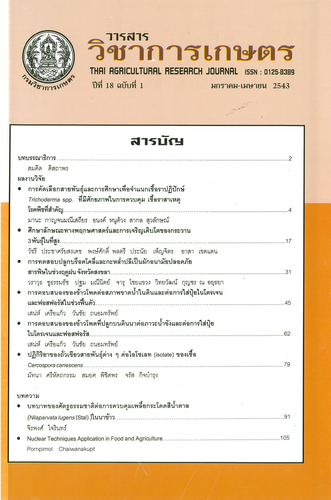การตอบสนองของข้าวโพดที่ปลูกบนดินนาต่อภาวะน้ำขังและต่อการใส่ปุ๋ยไนโตรเจนและฟอสฟอรัส
DOI:
https://doi.org/10.14456/thaidoa-agres.2000.5คำสำคัญ:
ข้าวโพด, ภาวะดินน้ำขัง, ดินนา, การฟื้นตัว, อัตราการเจริญเติบโตสัมพัทธ์บทคัดย่อ
ได้ศึกษาการเจริญเติบโต และระดับไนโตรเจน (N) และฟอสฟอรัส (P) ของข้าวโพดพันธุ์ผสมเปิดนครสวรรค์ 1 และพันธุ์ลูกผสม CP-DL 888 ที่ปลูกบนดินนา (ชุดราชบุรี) ในช่วงประสบกับภาวะน้ำขัง และช่วงฟื้นตัว ต่อการใส่ปุ๋ย N และ P ในเรือนทดลอง ศูนย์วิจัยพืชไร่นครสวรรค์ (ฤดูแล้งปี 2540) โดยปลูกข้าวโพดในกระถางให้ประสบกับภาวะดินน้ำขังที่ 14 วันหลังงอก (DAE) (ให้น้ำท่วมขัง 3 วัน แล้วปล่อยให้น้ำแห้งตามธรรมชาติ) และที่ 24 DAE เมื่อความชื้นของดินที่ถูกน้ำขังได้ลดลงต่ำกว่าระดับ field capacity (FC) แล้วจึงให้น้ำถึง FC ทุก ๆ วันจนถึง 38 DAE (24-38 DAE เป็นช่วงฟื้นตัว) ทันทีก่อนปลูกได้ใส่ปุ๋ย 2 วิธีการ คือ ไม่ใส่ปุ๋ย หรือใส่ปุ๋ย N และ P ร่วมกัน และที่ 24 DAE (วันเริ่มฟื้นตัว) มีการใส่ปุ๋ย 4 วิธี คือไม่ม่การใส่ปุ๋ย ใส่ N หรือ P อย่างเดียว หรือ N ร่วมกับ P (รูป P) (อย่างละ 10 กก./ไร่) ในขณะเดียวกันได้ศึกษาอิทธิพลของภาวะน้ำท่วมขังที่ 14 และ 28 DAE (ให้น้ำท่วมแปลงทดลอง 2 วัน แล้วปล่อยให้น้ำแห้งตามธรรมชาติ) ต่อการเจริญเติบโต ลักษณะทางพืชไร่และผลผลิตของพันธุ์นครสวรรค์ 1 และ CP-DK 888 และลูกผสมอื่น ๆ อีก 6 พันธุ์ ได้แก่ Hercules 40, Cargill 717, Pioneer 3012, Pacific 47, SW 3601 และ NSX 9008 ที่ปลูกในแปลงทดลองสภาพดินนาที่ศูนย์วิจัยพืชไร่ชัยนาท (ดินชุดเดียวกัน) พบว่า ภาวะดินน้ำขัง (ในกระถาง) ทำให้การเจริญเติบโต (อัตราการเพิ่มน้ำหนักแห้งและพื้นที่ใบสัมพัทธ์) และเปอร์เซ็นต์ N และ P ในส่วนต่าง ๆ ของข้าวโพดทั้ง 2 พันธุ์ลดลง ในช่วงที่ดินอยู่ในภาวะน้ำขังนั้น ข้าวโพด CP-DK 888 มีการเจริญเติบโตดีกว่า นครสวรรค์ CP-DK 888 ในช่วงฟื้นตัว การใส่ปุ๋ย N และ P พร้อมปลูก ทำให้ข้าวโพดดูดธาตุอาหาร N และ P และเติบโตดีขึ้นก่อนมีน้ำท่วมขัง แต่ไม่สามารถช่วยให้ข้าวโพดเติบโตดีขึ้นในช่วงที่ประสบภาวะดินน้ำขัง และบางส่วนของปุ๋ย N ได้สูญหายไป แต่การใส่ปุ๋ย N และ P ทันทีที่ข้าวโพดฟื้นตัว (รวมทั้งทีใส่พร้อมปลูก) สามารถช่วยเร่งการฟื้นตัวของข้าวโพดทั้ง 2 พันธุ์ ได้ ในขณะที่ภาวะดินน้ำขังในแปลงทดลองทำให้ข้าวโพดออกดอกตัวผู้ล่าออกไป 1-2 วัน และมี ASI กว้างขึ้น 2-5 วัน (ยกเว้น DP-DK 888) และทำให้ความสูง จำนวนเมล็ดต่อฝักและน้ำหนักเมล็ดและผลผลิตของข้าวโพดทั้ง 8 พันธุ์ ลดลง แต่สัดส่วนความเสียหายแตกต่างกันไปในแต่ละพันธ์ โดยผลผลิตของ Pioneer 3012 และ Cargill 717 ลดลง น้อยสุด 52% และ SW 3601 และ นครสวรรค์ 1 ลดลงมากที่สุด 94% มีความสัมพันธ์แบบเส้นตรงทางบวกระหว่างผลผลิตของข้าวโพดที่ปลูกในสภาพที่ดินกระทบกับภาวะน้ำขัง และที่ดินไม่มีภาวะน้ำขัง (r=0.87**)
ดาวน์โหลด
เผยแพร่แล้ว
รูปแบบการอ้างอิง
ฉบับ
ประเภทบทความ
สัญญาอนุญาต

อนุญาตภายใต้เงื่อนไข Creative Commons Attribution-NonCommercial-NoDerivatives 4.0 International License.
วารสารวิชาการเกษตร



